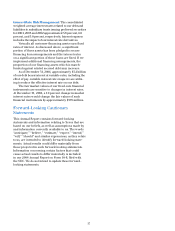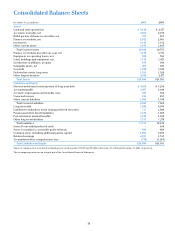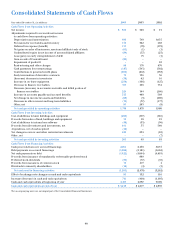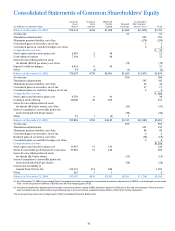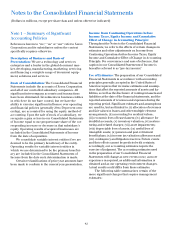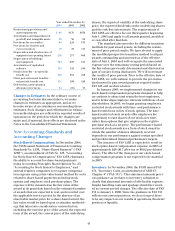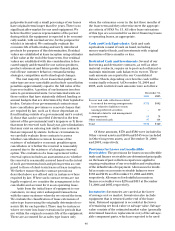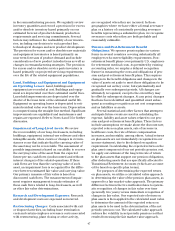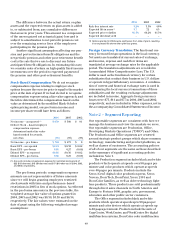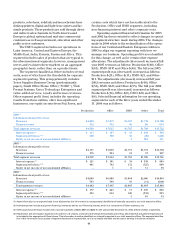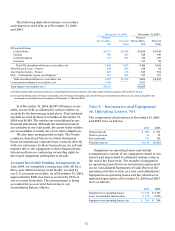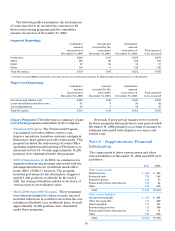Xerox 2004 Annual Report Download - page 49
Download and view the complete annual report
Please find page 49 of the 2004 Xerox annual report below. You can navigate through the pages in the report by either clicking on the pages listed below, or by using the keyword search tool below to find specific information within the annual report.
47
in the remanufacturing process. We regularly review
inventory quantities and record a provision for excess
and/or obsolete inventory based primarily on our
estimated forecast of product demand, production
requirements and servicing commitments. Several
factors may influence the realizability of our invento-
ries, including our decision to exit a product line,
technological changes and new product development.
The provision for excess and/or obsolete raw materials
and equipment inventories is based primarily on
near term forecasts of product demand and include
consideration of new product introductions as well as
changes in remanufacturing strategies. The provision
for excess and/or obsolete service parts inventory is
based primarily on projected servicing requirements
over the life of the related equipment populations.
Land, Buildings and Equipment and Equipment
on Operating Leases: Land, buildings and
equipment are recorded at cost. Buildings and equip-
ment are depreciated over their estimated useful lives.
Leasehold improvements are depreciated over the
shorter of the lease term or the estimated useful life.
Equipment on operating leases is depreciated to esti-
mated residual value over the lease term. Depreciation
is computed using the straight-line method. Significant
improvements are capitalized and maintenance and
repairs are expensed. Refer to Notes 4 and 5 for further
discussion.
Impairment of Long-Lived Assets: Wereview
the recoverability of our long-lived assets, including
buildings, equipment, internal-use software and other
intangible assets, when events or changes in circum-
stances occur that indicate that the carrying value of
the asset may not be recoverable. The assessment of
possible impairment is based on our ability to recover
the carrying value of the asset from the expected
future pre-tax cash flows (undiscounted and without
interest charges) of the related operations. If these
cash flows are less than the carrying value of such
asset, an impairment loss is recognized for the differ-
ence between estimated fair value and carrying value.
Our primary measure of fair value is based on
discounted cash flows. The measurement of impair-
ment requires management to make estimates of
these cash flows related to long-lived assets, as well
as other fair value determinations.
Research and Development Expenses: Research
and development costs are expensed as incurred.
Restructuring Charges: Costs associated with exit
or disposed activities, including lease termination
costs and certain employee severance costs associated
with restructuring, plant closing or other activity,
are recognized when they are incurred. In those
geographies where we have either a formal severance
plan or a history of consistently providing severance
benefits representing a substantive plan, we recognize
severance costs when they are both probable and
reasonably estimable.
Pension and Post-Retirement Benefit
Obligations: We sponsor pension plans in various
forms in several countries covering substantially all
employees who meet eligibility requirements. Post-
retirement benefit plans cover primarily U.S. employees
for retirement medical costs. As permitted by existing
accounting rules, we employ a delayed recognition
feature in measuring the costs and obligations of pen-
sion and post-retirement benefit plans. This requires
changes in the benefit obligations and changes in the
value of assets set aside to meet those obligations to be
recognized not as theyoccur, but systematically and
gradually over subsequent periods. All changes are
ultimately recognized, except to the extent they may
be offset bysubsequent changes. Atany point, changes
that have been identified and quantified await subse-
quent accounting recognition as net cost components
and as liabilities or assets.
Several statistical and other factors that attempt to
anticipate future events are used in calculating the
expense, liability and asset values related to our pen-
sion and post-retirement benefitplans. These factors
include assumptions we make about the discount rate,
expected return on plan assets, rate of increase in
healthcare costs, the rate of future compensation
increases, and mortality, among others. Actual returns
on plan assets are not immediately recognized in our
income statement, due to the delayed recognition
requirement. In calculating the expected return on the
plan asset component of our net periodic pension cost,
we apply our estimate of the long term rate of return
to the plan assets that support our pension obligations,
after deducting assets that are specifically allocated to
Transitional Retirement Accounts (which are account-
ed for based on specific plan terms).
For purposes of determining the expected return
on plan assets, we utilize a calculated value approach
in determining the value of the pension plan assets, as
opposed to a fair market value approach. The primary
difference between the two methods relates to system-
atic recognition of changes in fair value over time
(generally two years) versus immediate recognition of
changes in fair value. Our expected rate of return on
plan assets is then applied to the calculated asset value
to determine the amount of the expected return on
plan assets to be used in the determination of the net
periodic pension cost. The calculated value approach
reduces the volatility in net periodic pension cost that
results from using the fair market value approach.


